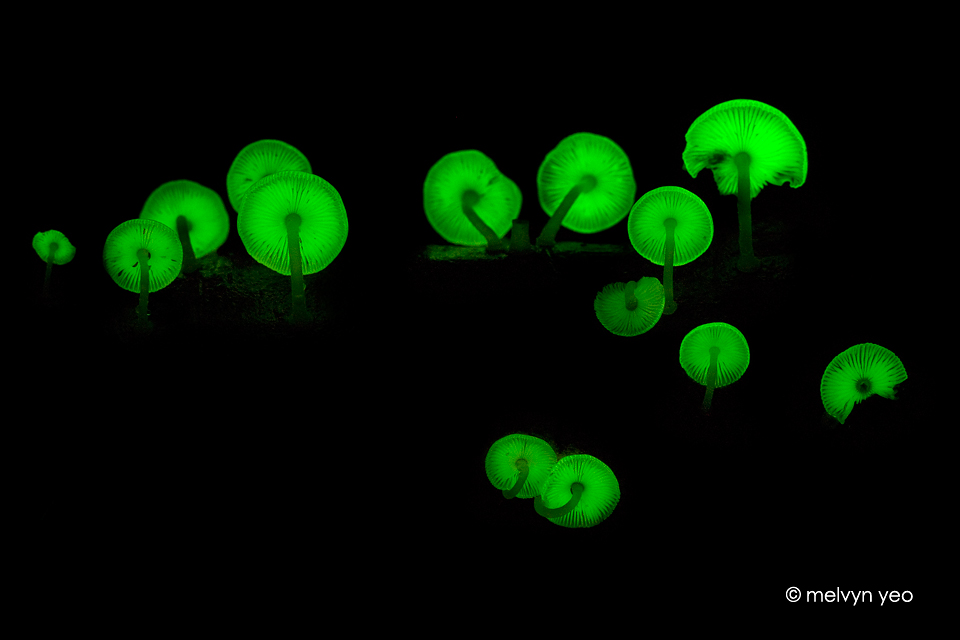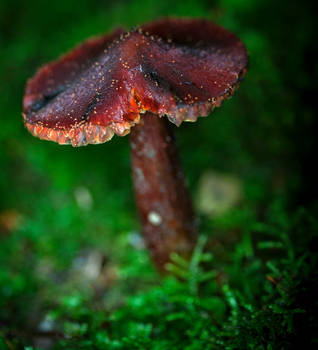ShopDreamUp AI ArtDreamUp
Deviation Actions
Suggested Deviants
Suggested Collections
You Might Like…
Featured in Groups
Description
Taken at night in Singapore. Still searching for a large cluster 
Quote from en.wikipedia.org/wiki/List_of_…
Found largely in temperate and tropical climates, there are more than 70 species of bioluminescent fungi, all of which are members of the order Agaricales. All known representatives are mushroom-forming, white-spored agarics that belong to four distinct evolutionary lineages. The Omphalotus lineage (comprising the genera Omphalotus and Neonothopanus) contains 12 species, the Armillaria lineage has 5 species, while the Mycenoid lineage (Mycena, Panellus, Prunulus, Roridomyces) has 47 species. The recently discovered Lucentipes lineage contains two species, Mycena lucentipes and Gerronema viridilucens, which belong to a family that has not yet been formally named.[1] Armillaria mellea is the most widely distributed of the luminescent fungi, found across Asia, Europe, North America, and South Africa.[2]
Bioluminescent fungi emit a greenish light at a wavelength of 520–530 nm. The light emission is continuous and occurs only in living cells.[3] No correlation of fungal bioluminescence with cell structure has been found. Bioluminescence may occur in both mycelia and fruit bodies, as in Panellus stipticus and Omphalotus olearius, or only in mycelia and young rhizomorphs, as in Armillaria mellea.[4] In Mycena rorida luminescence occurs only in the spores, while in Collybia tuberosa, it is only in the sclerotia.[5]
Although the biochemistry of fungal bioluminescence has not fully been characterized, the preparation of bioluminescent, cell-free extracts has allowed researchers to characterize the in vitro requirements of fungal bioluminescence. Experimental data suggest that a two-stage mechanism is required. In the first, a light-emitting substance (arbitrarily called "luciferin") is reduced by a soluble reductase enzyme at the expense of NAD(P)H. In the second stage, reduced luciferin is oxidized by an insoluble luciferase that releases the energy in the form of bluish-green light. Conditions that affect the growth of fungi, such as pH, light and temperature, have been found to influence bioluminescence, suggesting a link between metabolic activity and fungal bioluminescence.[5]
All bioluminescent fungi share the same enzymatic mechanism, suggesting that there is a bioluminescent pathway that arose early in the evolution of the mushroom-forming Agaricales.[1] All known luminescent species are white rot fungi capable of breaking down the complex carbohydrate lignin, found in abundance in wood. Bioluminescence is an oxygen-dependent metabolic process because it provides antioxidant protection against the potentially damaging effects of reactive oxygen species produced during wood decay. The physiological and ecological function of fungal bioluminescence has not been established with certainty. It has been suggested that in the dark beneath closed tropical forest canopies, bioluminescent fruit bodies may be at an advantage by attracting grazing animals (including insects and other arthropods) that could help disperse their spores. Conversely, where mycelium (and vegetative structures like rhizomorphs and sclerotia) are the bioluminescent tissues, the argument has been made that light emission could deter grazing.
Quote from en.wikipedia.org/wiki/List_of_…
Found largely in temperate and tropical climates, there are more than 70 species of bioluminescent fungi, all of which are members of the order Agaricales. All known representatives are mushroom-forming, white-spored agarics that belong to four distinct evolutionary lineages. The Omphalotus lineage (comprising the genera Omphalotus and Neonothopanus) contains 12 species, the Armillaria lineage has 5 species, while the Mycenoid lineage (Mycena, Panellus, Prunulus, Roridomyces) has 47 species. The recently discovered Lucentipes lineage contains two species, Mycena lucentipes and Gerronema viridilucens, which belong to a family that has not yet been formally named.[1] Armillaria mellea is the most widely distributed of the luminescent fungi, found across Asia, Europe, North America, and South Africa.[2]
Bioluminescent fungi emit a greenish light at a wavelength of 520–530 nm. The light emission is continuous and occurs only in living cells.[3] No correlation of fungal bioluminescence with cell structure has been found. Bioluminescence may occur in both mycelia and fruit bodies, as in Panellus stipticus and Omphalotus olearius, or only in mycelia and young rhizomorphs, as in Armillaria mellea.[4] In Mycena rorida luminescence occurs only in the spores, while in Collybia tuberosa, it is only in the sclerotia.[5]
Although the biochemistry of fungal bioluminescence has not fully been characterized, the preparation of bioluminescent, cell-free extracts has allowed researchers to characterize the in vitro requirements of fungal bioluminescence. Experimental data suggest that a two-stage mechanism is required. In the first, a light-emitting substance (arbitrarily called "luciferin") is reduced by a soluble reductase enzyme at the expense of NAD(P)H. In the second stage, reduced luciferin is oxidized by an insoluble luciferase that releases the energy in the form of bluish-green light. Conditions that affect the growth of fungi, such as pH, light and temperature, have been found to influence bioluminescence, suggesting a link between metabolic activity and fungal bioluminescence.[5]
All bioluminescent fungi share the same enzymatic mechanism, suggesting that there is a bioluminescent pathway that arose early in the evolution of the mushroom-forming Agaricales.[1] All known luminescent species are white rot fungi capable of breaking down the complex carbohydrate lignin, found in abundance in wood. Bioluminescence is an oxygen-dependent metabolic process because it provides antioxidant protection against the potentially damaging effects of reactive oxygen species produced during wood decay. The physiological and ecological function of fungal bioluminescence has not been established with certainty. It has been suggested that in the dark beneath closed tropical forest canopies, bioluminescent fruit bodies may be at an advantage by attracting grazing animals (including insects and other arthropods) that could help disperse their spores. Conversely, where mycelium (and vegetative structures like rhizomorphs and sclerotia) are the bioluminescent tissues, the argument has been made that light emission could deter grazing.
Image size
960x640px 205.22 KB
Make
Canon
Model
Canon EOS 5D Mark II
Shutter Speed
25/1 second
Aperture
F/11.0
Focal Length
100 mm
ISO Speed
800
Date Taken
Dec 7, 2013, 2:58:57 AM
Sensor Size
6mm
© 2013 - 2024 melvynyeo
Comments14
Join the community to add your comment. Already a deviant? Log In
This is just too amazing!!!!


































